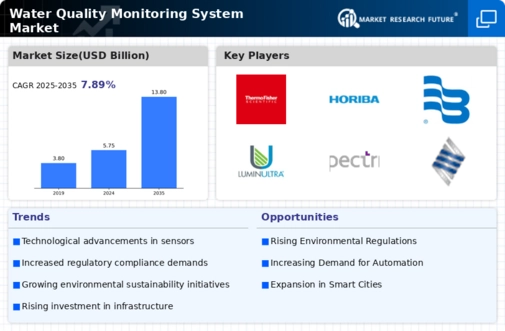Technological Advancements
Technological innovations in sensor technology and data analytics are transforming the Water Quality Monitoring System Market. The integration of IoT devices and cloud computing enables real-time monitoring and data collection, which enhances the accuracy and efficiency of water quality assessments. As of October 2025, the market for smart water quality monitoring systems is expected to expand significantly, with a projected increase in the adoption of automated systems. These advancements not only facilitate better decision-making but also reduce operational costs for water management authorities. The ability to analyze large datasets allows for predictive analytics, which can preemptively address potential water quality issues, thus ensuring safer water supplies.
Rising Environmental Concerns
The increasing awareness regarding environmental degradation and its impact on public health appears to be a primary driver for the Water Quality Monitoring System Market. As communities and governments recognize the importance of maintaining clean water sources, investments in monitoring systems are likely to rise. Reports indicate that the market is projected to grow at a compound annual growth rate of approximately 7.5% over the next five years. This growth is driven by the need for real-time data on water quality to ensure compliance with environmental regulations. Furthermore, the demand for sustainable water management practices is pushing organizations to adopt advanced monitoring technologies, thereby enhancing the overall effectiveness of water quality management.
Urbanization and Population Growth
Rapid urbanization and population growth are exerting pressure on water resources, thereby driving the Water Quality Monitoring System Market. As urban areas expand, the demand for clean and safe drinking water intensifies, necessitating effective monitoring systems. The market is expected to grow as municipalities and water authorities seek to implement comprehensive water quality management strategies. With an increasing number of people relying on centralized water systems, the need for continuous monitoring becomes paramount. This trend suggests that investments in water quality monitoring technologies will likely increase, as stakeholders aim to ensure the safety and sustainability of water supplies in densely populated regions.
Regulatory Pressures and Compliance
The stringent regulatory frameworks governing water quality standards are compelling organizations to invest in monitoring systems. The Water Quality Monitoring System Market is experiencing growth due to the need for compliance with local and international regulations. As authorities enforce stricter guidelines, companies are increasingly adopting advanced monitoring solutions to avoid penalties and ensure public safety. The market is projected to witness a surge in demand for compliance-driven monitoring systems, particularly in industries such as agriculture, manufacturing, and municipal water supply. This trend indicates a shift towards proactive water quality management, where organizations prioritize compliance as a key component of their operational strategies.
Increased Investment in Water Infrastructure
The Water Quality Monitoring System Industry. Governments and private entities are allocating substantial resources to upgrade aging water systems and enhance monitoring capabilities. This investment trend is expected to bolster the market, as modernized infrastructure requires advanced monitoring solutions to ensure water quality. Reports indicate that the market could see a growth rate of around 6% annually, driven by infrastructure projects aimed at improving water safety and accessibility. The focus on sustainable development and efficient resource management further underscores the importance of investing in water quality monitoring systems.


















Leave a Comment